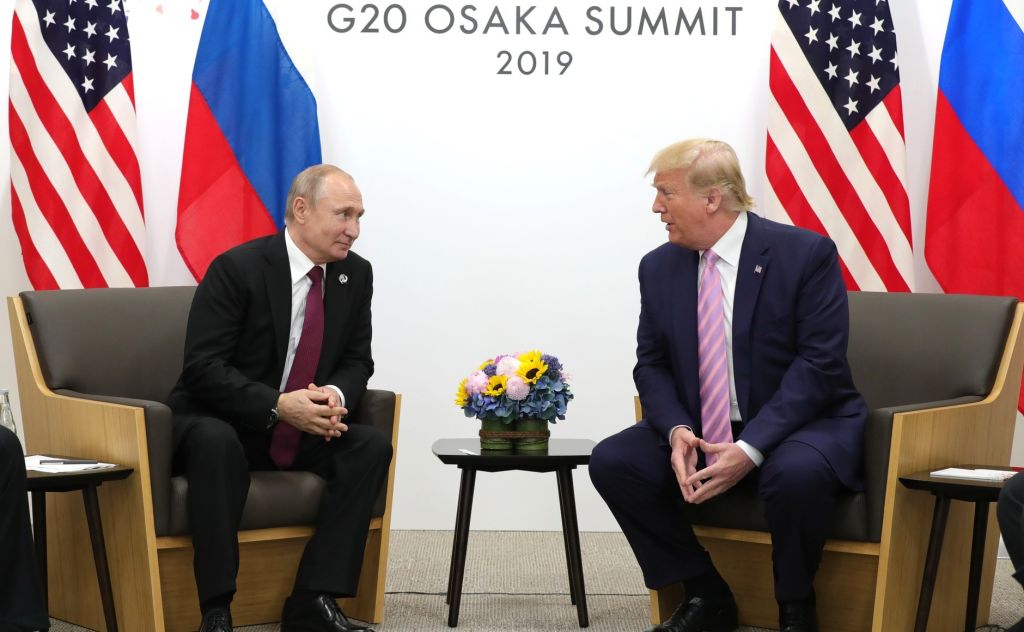
It is not difficult to imagine a future in which those who can afford the best AI political systems will routinely win elections, referenda, and other important votes.
* * *
During his joint press appearance with Russia’s President Vladimir Putin prior to their meeting at the G20 Summit in Osaka, President Donald Trump provoked new controversy in the United States by jokingly telling Putin, “Don’t meddle in the election” after a reporter asked whether he would raise the issue during his conversation with the Russian leader. [https://www.nytimes.com/2019/06/28/us/politics/trump-putin-election.html]
Trump’s continuing refusal to take Russia’s election interference seriously in his public statements is understandable—he has a strong incentive to avoid delegitimizing his 2016 victory—but also counterproductive, as the problem is a real one, and Trump’s denials unnecessarily enrage his opponents and baffle many others. Nevertheless, outside interference like Russia’s is not the only threat to twenty-first century democracies; even as they empower foreign governments, the new technologies of politics are giving powerful new tools to candidates’ political campaigns, to political parties and, in the United States, to well-funded issue advocacy groups. This should prompt greater concern than it has, and requires action to protect the meaning of democracy.
Trump’s defenders [https://www.npr.org/2019/04/24/716374421/fact-check-russian-interference-went-far-beyond-facebook-ads-kushner-described] regularly cite Moscow’s minimal spending on Facebook advertising, just $160,000 over a period of several years, according to Facebook [https://newsroom.fb.com/news/2019/01/removing-cib-from-russia/] as evidence that Russia’s activity could not have influenced an election in which domestic spending on digital advertising reached $650 million. [https://www.mediapost.com/publications/article/337563/2020-political-spending-to-hit-6-billion-digital.html] The disparity is stark, though it does not in itself disprove impacts that St. Petersburg’s Internet Research Agency may have produced through its work, the magnitude of which we are likely never to know.
Expanding Budgets and Capabilities for Digital Political Advertising
In addition to demonstrating Russia’s limited expenditures, however, these statistics show the size of America’s market for political advertising, which the prominent media and advertising analytics firm Kantar Media estimates will reach $6 billion during the 2019–20 election cycle. [https://www.kantarmedia.com/us/newsroom/press-releases/kantar-forecasts6-billion-in-political-ad-spending-for-2019-2020-election-cycle] Analysts expect digital political advertising to reach $1.2 billion, almost double its 2016 levels. These amounts are unprecedented and growing.
Even so, political advertising is a small share of overall US online advertising spending, some $107.5 billion in 2018. [https://techcrunch.com/2019/05/07/iab-internet-advertising-report/] This matters because with over $100 billion up for grabs in the United States alone, advertising firms are competing energetically to deliver the best messages for their clients—where “best” means most effective in persuading viewers, listeners, or readers to take action, whether buying a product or service or voting for a particular candidate. This increasingly includes an arms race to develop artificial intelligence algorithms that continuously develop, test, and refine messages that target not merely certain groups but even individuals.
By the time of the 2016 election, these capabilities had advanced sufficiently to allow presidential son-in-law Jared Kushner to lead a 100-person data and messaging team that, according to many observers, contributed substantially to Trump’s victory. In a post-election interview, Kushner described how this operation applied online marketing techniques that the article described as “message tailoring, sentiment manipulation, and machine learning” to identify, contact, and persuade voters. According to the interview, this data team designed “a custom geo-location tool that plotted the location density of about 20 voter types” through Google Maps, something that allowed the campaign to allocate spending precisely in areas that promised high returns in votes. [https://www.forbes.com/sites/stevenbertoni/2016/11/22/exclusive-interview-how-jared-kushner-won-trump-the-white-house/#12dded203af6]
In part as a result of this, Trump’s campaign was half the cost of Hillary Clinton’s losing effort, and Trump was able to win the presidency with narrow victories in key states that provided a majority of electoral college votes despite his lower national popularity.
Who Has the Best Policies, or Who Has the Best AI?
Perhaps more important in thinking about the future of democracy as a political system is that these capabilities remain quite new and are continuing to expand and to evolve, possibly quite rapidly in view of the money at stake (in advertising) and the power at stake (in elections). Adding continued growth due to Moore’s Law—the idea that the number of transistors on an individual silicon computer chip doubles every two years, doubling the chip’s processing power [https://www.britannica.com/technology/Moores-law]—suggests that the capability and influence of artificial intelligence (AI) in politics may increase exponentially, with each new national election in many countries becoming a proving ground for new digital tools.
Considering what neurologists, experimental psychologists, economists, and other researchers have already learned about human decision-making, and the further lessons that could emerge from applying machine learning to historical data to build and improve election models, it is not difficult to imagine a future in which those who can afford the best AI political systems will routinely win elections, referenda, and other important votes. With voters rarely seeking detailed information about candidates or issues and often relying on algorithm-based online news and information services to select what they need to know, the scope for abuse of these systems is alarming.
The best that one might say about such a world is that at least in democracies, voters would have two or more choices in their elections and that each side would have its own political AI systems. That is certainly more attractive than life in one-party systems in which the state could employ such systems to exert political influence without competition.
Yet on the other hand, coping with a continuous messaging war among multiple political AI systems and algorithms may well produce greater frustration and alienation within democratic societies already strained by populist anger—increasing another potential threat to democratic governance. Democracies have a responsibility to examine and address these challenges very soon.
